IndusInd Bank Bundle
How Does IndusInd Bank Stack Up in India's Banking Arena?
The Indian banking sector is a battlefield of innovation and competition, and IndusInd Bank SWOT Analysis reveals a dynamic player. Established in 1994, IndusInd Bank has rapidly expanded its reach, offering a comprehensive suite of financial services to a diverse customer base. From retail to wholesale banking, the bank's growth trajectory warrants a deep dive into its competitive positioning.
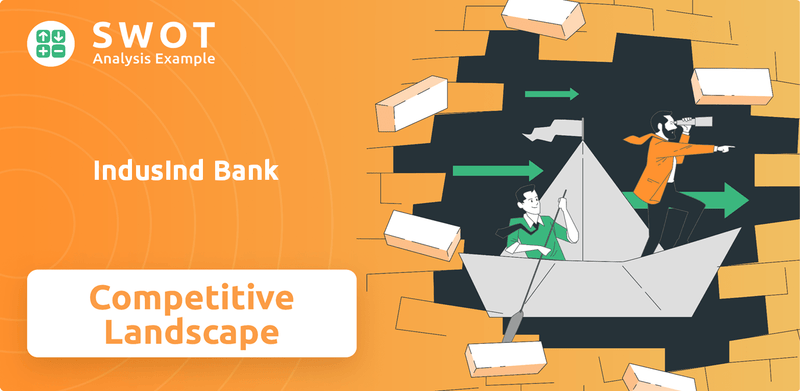
To truly grasp IndusInd Bank's potential, it's essential to dissect its competitive landscape. This analysis will explore the bank's market share, identify its industry rivals, and evaluate its competitive advantages within the financial institutions sector. Understanding the challenges faced by IndusInd Bank and its strategic responses provides critical insights into its future outlook and financial performance analysis within the ever-evolving banking sector.
Where Does IndusInd Bank’ Stand in the Current Market?
IndusInd Bank holds a significant market position within the Indian banking sector, consistently ranking among the top private sector banks. The bank's strategy focuses on a universal banking approach, offering a diverse mix of loans and deposits, which supports its strong market presence. As of March 31, 2025, the bank's balance sheet totaled ₹5,54,107 crore, reflecting an 8% growth from the previous year.
The bank's primary services include corporate banking, retail banking, treasury services, and foreign exchange investment banking. It serves a wide range of customers, from individuals to large corporations. IndusInd Bank has established expertise in vehicle finance and microfinance, especially in rural India. The bank's extensive branch and ATM network further enhances its reach and accessibility across the country.
IndusInd Bank's focus on digital transformation is evident, with a significant portion of transactions conducted through digital channels. The bank's financial performance has been impacted by recent challenges, including higher provisioning and accounting discrepancies. Despite these issues, the bank maintains a healthy capital adequacy ratio.
IndusInd Bank maintains a strong position in the banking sector analysis, particularly among private sector banks. Its market share is supported by a diversified portfolio and extensive branch network. The bank's focus on both corporate and retail banking contributes to its competitive advantage.
For the fiscal year 2024, IndusInd Bank reported a net profit of ₹8,977 crore. However, in FY25, the net profit decreased to ₹2,576 crore. The bank's total assets stood at ₹515,094 crore in FY24. Despite recent challenges, the bank maintains a healthy capital adequacy ratio.
IndusInd Bank has shown a clear shift towards digital transformation, with 82% of its transactions conducted through digital channels as of 2022. The INDIE Digital Banking App, launched in December 2024, is a key initiative. These efforts aim to enhance customer experience and operational efficiency.
As of March 31, 2024, the bank had 2,984 branches/banking outlets and 2,956 ATMs. By December 2024, the branch network further expanded to 3,063 branches and 2,993 ATMs. The bank serves a wide array of customer segments, from individuals to large corporations.
The competitive landscape for IndusInd Bank includes both public and private sector banks. Key competitors include other major financial institutions operating in India. Understanding the industry rivals is crucial for assessing IndusInd Bank's market position.
- IndusInd Bank's focus on niche segments such as vehicle finance and microfinance provides a competitive edge.
- The bank's digital initiatives and expanding branch network support its growth strategy.
- Despite recent challenges, the bank's healthy capital adequacy ratio indicates financial stability.
- For more details, you can read a Brief History of IndusInd Bank.
IndusInd Bank SWOT Analysis
- Complete SWOT Breakdown
- Fully Customizable
- Editable in Excel & Word
- Professional Formatting
- Investor-Ready Format
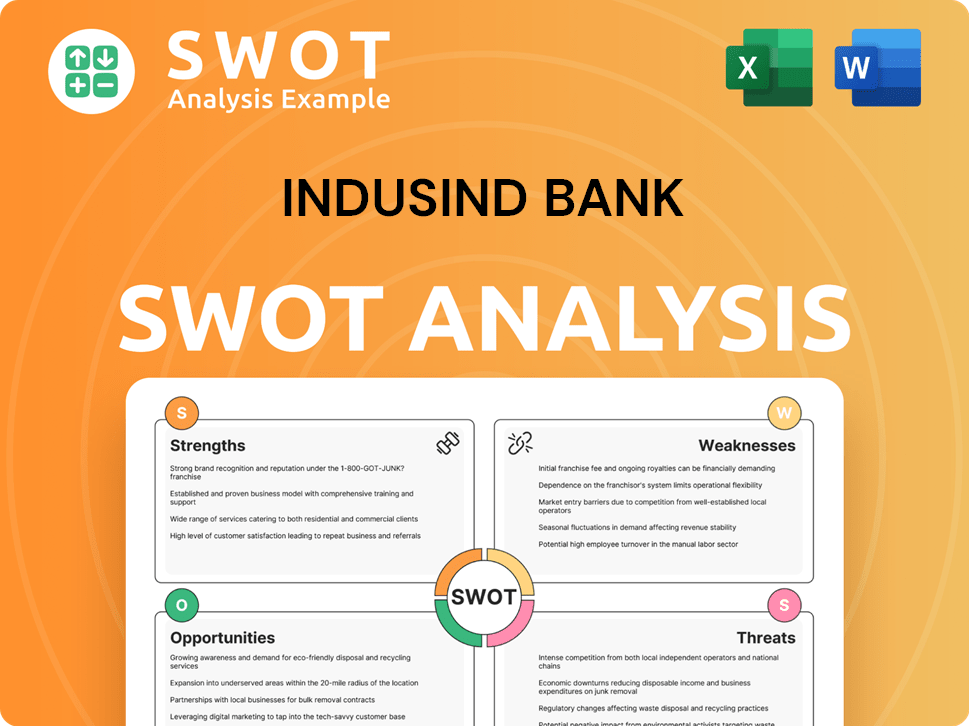
Who Are the Main Competitors Challenging IndusInd Bank?
The competitive landscape for IndusInd Bank within the Indian banking sector is intense, encompassing both private and public sector banks. A thorough banking sector analysis reveals a dynamic environment where market share and strategic initiatives are constantly evolving. Understanding the competitive landscape is crucial for assessing IndusInd Bank's market position and its ability to sustain growth.
IndusInd Bank faces stiff competition from established players and emerging fintech companies. This competitive pressure necessitates continuous innovation and adaptation to maintain and improve its standing. The bank’s performance is directly influenced by its ability to differentiate itself through customer service, technological advancements, and strategic financial decisions.
The Indian banking sector is highly competitive, with financial institutions vying for market share. Several key players directly compete with IndusInd Bank. These include HDFC Bank, ICICI Bank, and Axis Bank, all of which have significant footprints in the retail and corporate banking segments. These banks offer a wide range of financial products and services, competing for the same customer base as IndusInd Bank.
HDFC Bank is a major competitor, known for its strong presence in both retail and corporate banking. It consistently shows robust growth and has a vast customer base.
ICICI Bank offers a comprehensive suite of financial products and services. It has a large customer base and an extensive branch network, making it a formidable competitor.
Axis Bank is recognized for its innovative banking solutions and customer-centric approach. It competes directly with IndusInd Bank across various segments.
Kotak Mahindra Bank is known for its focus on customer service and technological advancements in private banking. It competes for the same segment of customers.
SBI is the largest public sector bank with a vast network and diverse product offerings. Its extensive reach and resources make it a significant competitor.
Emerging players and new digital banking platforms, such as MoneyTap, vCard, and GalaxyCard, also present competitive challenges to the digital banking initiatives of IndusInd Bank like INDIE.
The competitive dynamics also involve shifts in investor behavior. For instance, foreign portfolio investors (FPIs) reduced their holdings in IndusInd Bank from 40.51% in December 2023 to 24.41% by December 2024. During the same period, domestic institutional investors (DIIs) increased their stake, indicating a change in the investor profile and sentiment. To understand how IndusInd Bank generates revenue and its business model, you can read this article: Revenue Streams & Business Model of IndusInd Bank
Several factors influence the competitive landscape. These include market share, customer service, technological innovation, and financial performance. Understanding these factors is crucial for analyzing IndusInd Bank's competitive advantages.
- Market Share: The percentage of the total market controlled by a bank.
- Customer Service: The quality of service provided to customers, including responsiveness and problem-solving.
- Technological Innovation: The adoption and implementation of new technologies to improve banking services.
- Financial Performance: Key metrics such as profitability, asset quality, and capital adequacy.
IndusInd Bank PESTLE Analysis
- Covers All 6 PESTLE Categories
- No Research Needed – Save Hours of Work
- Built by Experts, Trusted by Consultants
- Instant Download, Ready to Use
- 100% Editable, Fully Customizable
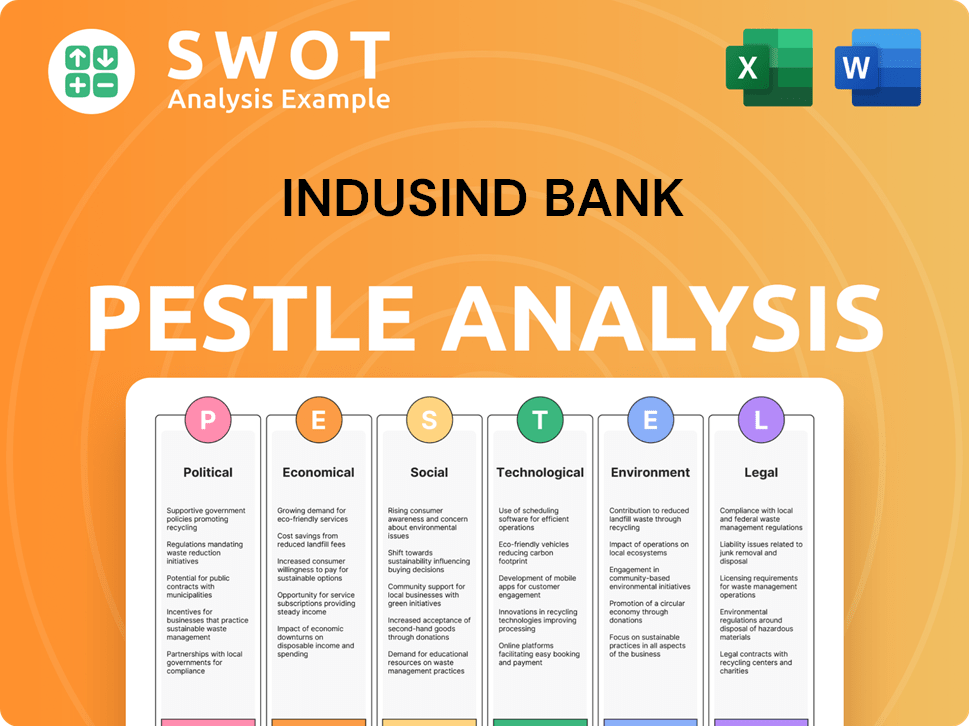
What Gives IndusInd Bank a Competitive Edge Over Its Rivals?
Analyzing the competitive landscape of IndusInd Bank reveals a strategic focus on customer-centric services and technological innovation. The bank's approach aims to build strong client relationships, supported by a diverse product range. This strategy, combined with a commitment to digital transformation, positions it uniquely within the banking sector.
IndusInd Bank's market position is shaped by its ability to adapt and innovate. The bank has made significant investments in digital banking solutions and strategic partnerships, enhancing its competitive advantages. Its focus on sustainability and specialized financial services further differentiates it from industry rivals.
The bank's financial performance analysis highlights its strategic moves to enhance its market share. While facing challenges related to geographical reach, IndusInd Bank has demonstrated resilience and growth through its customer-focused approach and digital initiatives. For a deeper dive into its growth strategies, consider exploring the Growth Strategy of IndusInd Bank.
IndusInd Bank prioritizes personalized services to build lasting client relationships. This customer-centric model is a key differentiator in the competitive landscape. The bank's focus on understanding and meeting customer needs helps it maintain a strong customer base.
The bank offers a wide range of products, including corporate and retail banking, treasury services, and foreign exchange. This diversification allows IndusInd Bank to serve a broad customer base. It also generates multiple revenue streams, enhancing its financial stability.
IndusInd Bank invests heavily in digital banking solutions, including mobile apps and online platforms. In 2022, 82% of transactions were digital, showcasing a strong digital infrastructure. This technological edge is a significant competitive advantage.
The bank forms alliances with various companies to offer co-branded credit cards and loyalty programs. These partnerships expand the customer base and provide value-added services. Strategic collaborations enhance the bank's market reach and competitiveness.
IndusInd Bank's competitive advantages include its customer-centric approach, diverse product offerings, and technological innovation. Its domain expertise in vehicle finance and microfinance, particularly in rural India, provides a unique edge. The bank's commitment to sustainability is also a growing strength.
- Strong focus on customer relationships and personalized services.
- Significant investment in digital banking and innovative technologies.
- Strategic partnerships to expand customer reach and service offerings.
- Commitment to sustainable finance, with approximately 46% of total lending in 2023.
IndusInd Bank Business Model Canvas
- Complete 9-Block Business Model Canvas
- Effortlessly Communicate Your Business Strategy
- Investor-Ready BMC Format
- 100% Editable and Customizable
- Clear and Structured Layout
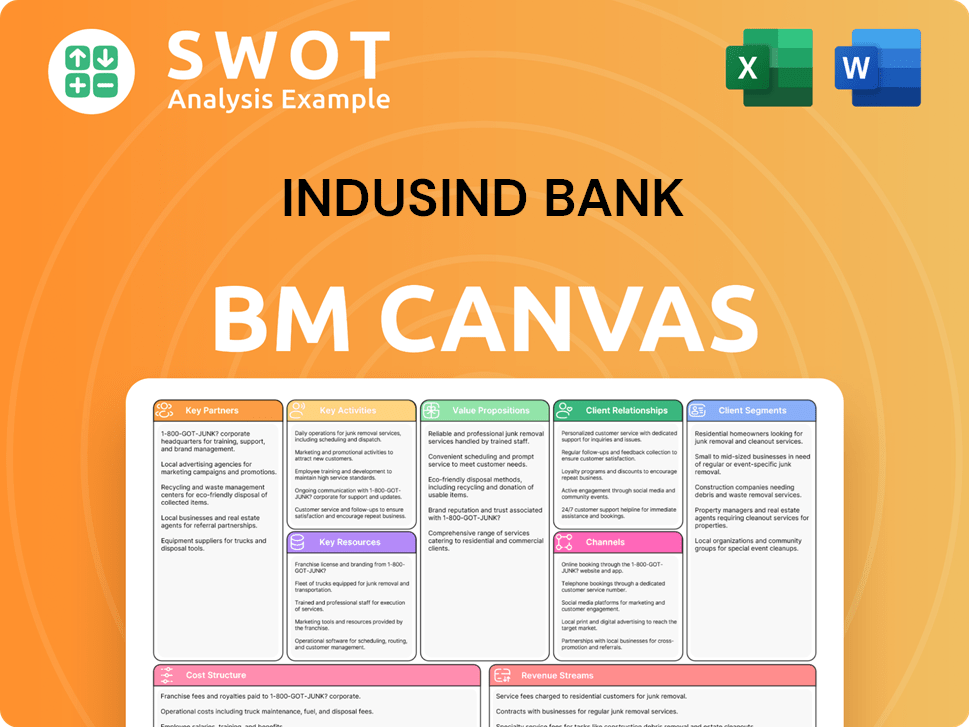
What Industry Trends Are Reshaping IndusInd Bank’s Competitive Landscape?
The Indian banking sector is currently experiencing significant shifts, driven by technological advancements, evolving regulations, and changing consumer preferences. The Target Market of IndusInd Bank faces a dynamic landscape. Several factors, including financial performance and strategic initiatives, will determine its future outlook.
The competitive landscape for financial institutions is intense, with both public and private banks vying for market share. Challenges such as moderate economic expansion and potential pressure on interest margins add to the complexity. Recent financial issues, including accounting lapses and a decline in net profit, pose immediate hurdles for the bank.
The digital banking sector in India is projected to reach approximately USD 1 trillion by 2025, fueled by increasing smartphone penetration. This creates opportunities for banks to enhance digital platforms. Credit growth in the banking sector is expected to be around 12.5% for FY25.
The competitive environment remains fierce, with well-established banks competing for market share. Moderate economic expansion and potentially low interest rates could pressure interest margins. Recent accounting lapses and balance sheet disclosures pose immediate challenges related to financial transparency.
The overall outlook for India's banking system for 2025 is stable, driven by healthy economic growth. The bank can leverage its presence in rural India and its expertise in microfinance. ESG-linked financing and strategic partnerships offer avenues for sustainable growth.
The banking sector is undergoing digital transformation, expanding product portfolios, and enhancing service offerings. Projections for loan and deposit growth remain positive. The Institute of Chartered Accountants of India (ICAI) is reviewing the bank's financial statements for FY24 and FY25.
The bank must navigate challenges related to financial transparency and regain investor confidence. It can capitalize on growth in rural India and microfinance. Strategic partnerships and ESG-linked financing are vital for sustainable growth.
- Focus on digital transformation and expanding product portfolios.
- Leverage expertise in microfinance and rural markets.
- Prioritize ESG-linked financing solutions.
- Enhance service offerings to maintain a competitive edge.
IndusInd Bank Porter's Five Forces Analysis
- Covers All 5 Competitive Forces in Detail
- Structured for Consultants, Students, and Founders
- 100% Editable in Microsoft Word & Excel
- Instant Digital Download – Use Immediately
- Compatible with Mac & PC – Fully Unlocked
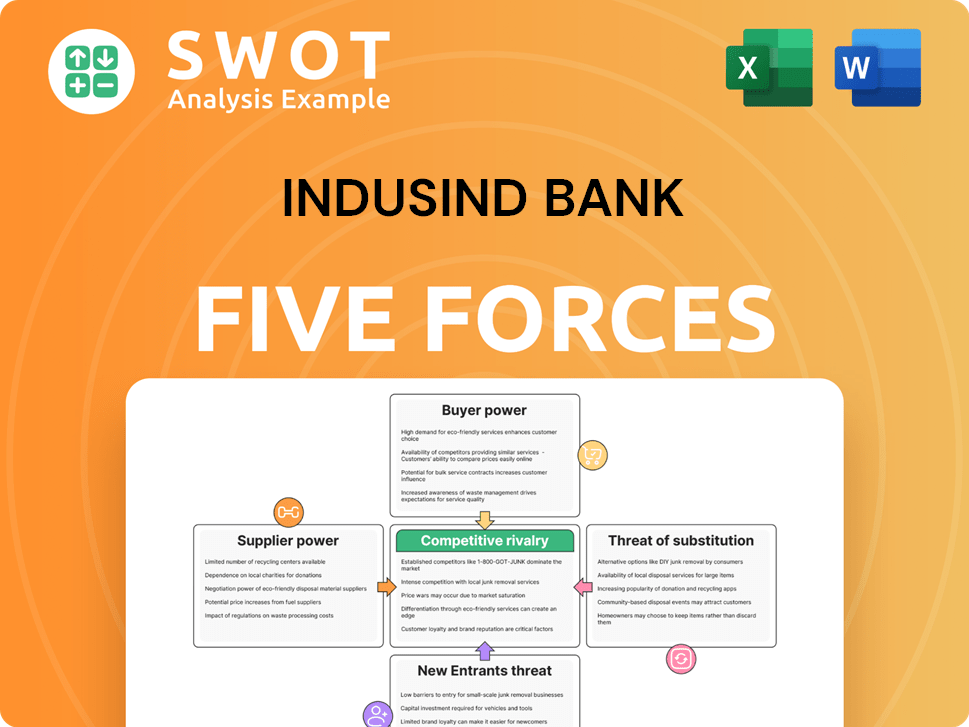
Related Blogs
- What are Mission Vision & Core Values of IndusInd Bank Company?
- What is Growth Strategy and Future Prospects of IndusInd Bank Company?
- How Does IndusInd Bank Company Work?
- What is Sales and Marketing Strategy of IndusInd Bank Company?
- What is Brief History of IndusInd Bank Company?
- Who Owns IndusInd Bank Company?
- What is Customer Demographics and Target Market of IndusInd Bank Company?
Disclaimer
All information, articles, and product details provided on this website are for general informational and educational purposes only. We do not claim any ownership over, nor do we intend to infringe upon, any trademarks, copyrights, logos, brand names, or other intellectual property mentioned or depicted on this site. Such intellectual property remains the property of its respective owners, and any references here are made solely for identification or informational purposes, without implying any affiliation, endorsement, or partnership.
We make no representations or warranties, express or implied, regarding the accuracy, completeness, or suitability of any content or products presented. Nothing on this website should be construed as legal, tax, investment, financial, medical, or other professional advice. In addition, no part of this site—including articles or product references—constitutes a solicitation, recommendation, endorsement, advertisement, or offer to buy or sell any securities, franchises, or other financial instruments, particularly in jurisdictions where such activity would be unlawful.
All content is of a general nature and may not address the specific circumstances of any individual or entity. It is not a substitute for professional advice or services. Any actions you take based on the information provided here are strictly at your own risk. You accept full responsibility for any decisions or outcomes arising from your use of this website and agree to release us from any liability in connection with your use of, or reliance upon, the content or products found herein.